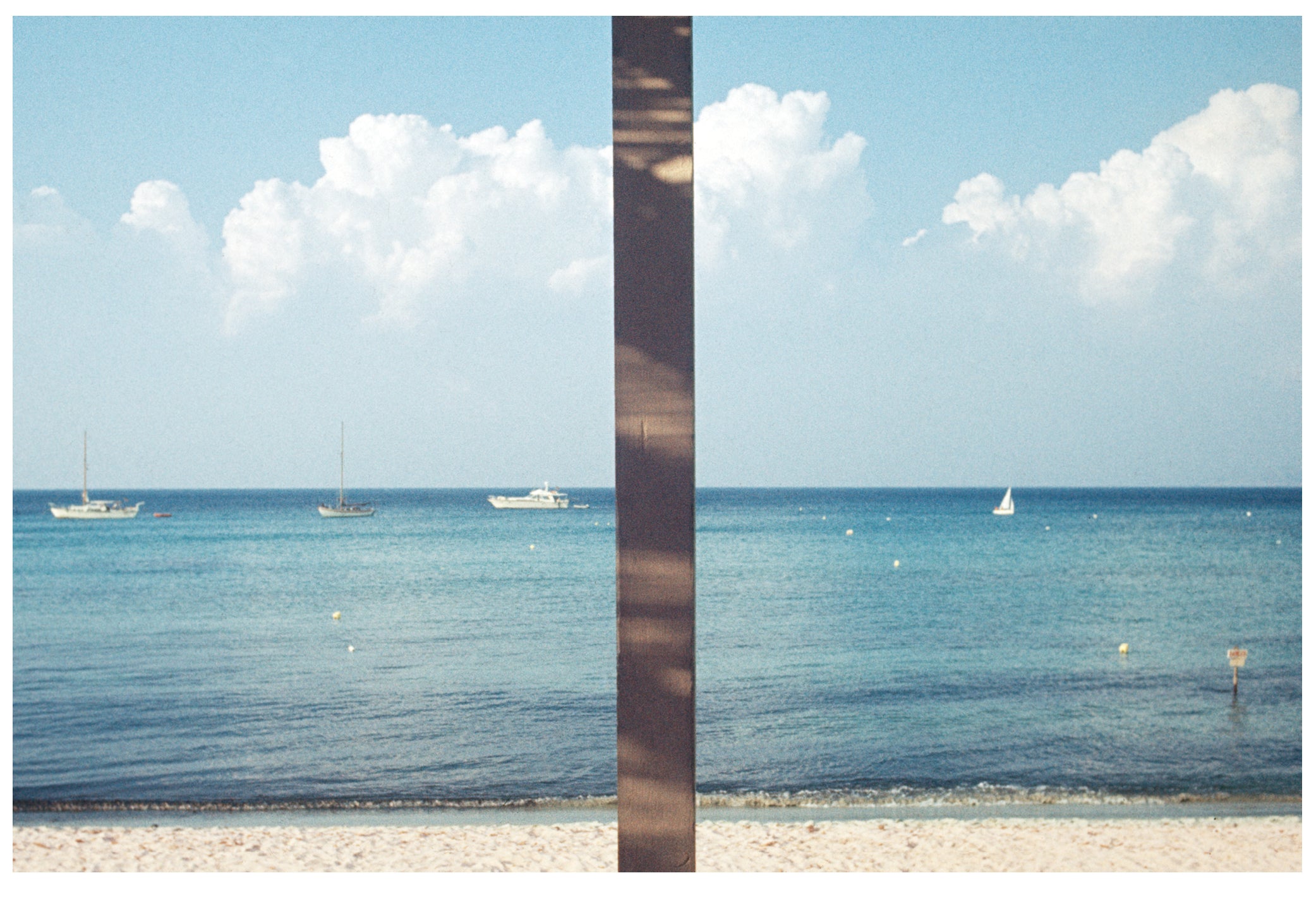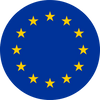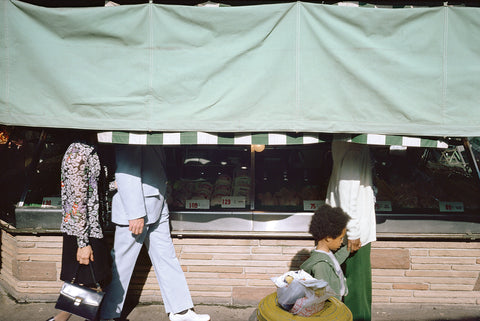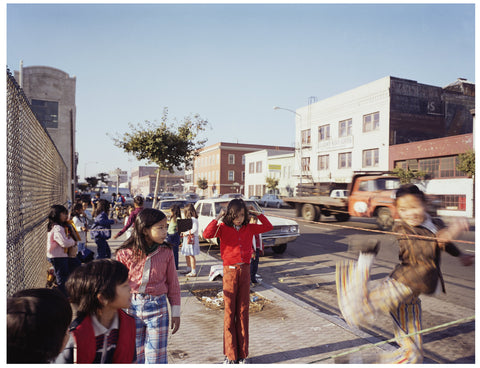English, Italian, French, German
Foreword by Luigi Ghirri (English)
I. In 1969 the photo taken from the space shuttle on its way to the moon is published in all newspapers; this was the first photograph of the World. The picture pursued for centuries by man was presented to our eyes, containing contemporarily all the preceding images, incomplete, all books written, all signs deciphered and not. It was not only the picture of the world, but the picture which contained all the pictures of the world: graffiti, frescoes, prints, paintings, writings, photographs, books, films. Simultaneously the representation of the world and all the representations of the world in one time only. On the other hand this total view, this redescription of everything, destroyed one more the possibility of translating the hieroglyphic whole. The power of containing everything vanished in front of the impossibility of seeing everything at the same time. The event and its representation, to see and to be contained, reappeared to man as not sufficient to solve eternal questions. This possibility of total duplication, however, let us glimpse the possibility of deciphering the hieroglyph; we had the two poles of doubt and of the secular mystery, the picture of the atom and the picture of the world, finally one in front of the other. The space between the infinitely small and the infinitely big was filled by the infinitely complex problem: man and his life, nature. The need for information or consciousness thus arises between two extreme points, oscillating from the microscope to the telescope in order to be able to translate and interpret reality or the hieroglyph.
II. My work rises from the necessity and the desire to interpret and translate the sign and meaning of this sum of hieroglyphs. So, not only a reality which is easily identifiable or highly loaded with symbols, but also thought, imagination, the fantastic and strange meanings. The photograph is extremely important for the aim I have set myself because of certain characteristic features of its language, which I shall try to explain. The cancellation of the space surrounding the framed part is for me as important as the represented part; it is because of this cancellation that the picture assumes a meaning and gets measurable.
At the same time the picture continues in the visible part of the cancellation, and it invites us to see the rest of the not represented reality. This double aspect of representation and cancellation not only tries to evoke the absence of limits, excluding any idea of completeness or finished thing, but it indicates something which cannot be delimitated, and that is the real. On the other hand, the possibility of seeing and penetrating the universe of reality passes through all the cultural representations and models known, and which have been given to us as definite and decisive, and our relationship with reality and life is the same relationship as the one of the picture from the satellite with the earth itself. So the photograph with its indeterminateness becomes a privileged subject in order to be able to get outside the symbolism of definite representations to which a certain value of truth has been given. The possibility of analysis in time, in the space of signs which form the reality whose completeness has always slipped our minds, thus permits the photograph, because of its fragmentary character to be closer to things which cannot be delimitated, and that is physical existence. That is why I am not interested in the pictures and the decisive moments, the study or the analysis of their language as an end in itself, aesthetics, the concept or totalizing idea, the emotions of the poet, the well-bred quotation, the search for a new aesthetic creed, the use of a style. I am occupied with seeing clearly, that is why I am interested in all possible functions, without separating anyone from the whole, but to assume then in a total way in order to be able to see and render recognizable from one time to another, the hieroglyphs I have met.
III. The daily encounter with reality, with the fictions and surrogates, the ambiguous aspects, poetical or alienating, seems to deny any way out of the labyrinth, whose walls are always more illusive even to the point of confusing ourselves with them. The meaning that I try to give to my work is that of the verification of how it is still possible to wish to face the way of knowledge, to make it possible at last to tell the real identity of man, of things, of life, from the image of man, of things, of life.

Prefazione di Luigi Ghirri (Italiano)
I. Nel 1969 viene pubblicata da tutti i giornali, la fotografia scattata dalla navicella spaziale in viaggio per la Luna; questa era la prima fotografia del Mondo. L’immagine rincorsa per secoli dall’uomo si presentava al nostro sguardo contenendo contemporaneamente tutte le immagini precedenti, incomplete, tutti i libri scritti, tutti i segni decifrati e non. Non era soltanto l’immagine del mondo, ma l’immagine che conteneva tutte le immagini del mondo: graffiti, affreschi, dipinti, stampe, scritture, fotografie, libri, films. Contemporaneamente la rappresentazione del mondo e tutte le rappresentazioni del mondo in una volta sola. Eppure questo sguardo totale, questo ridescrivere tutto, annullava ancora una volta la possibilità di tradurre il geroglifico-totale. Il potere di contenere tutto spariva davanti all’impossibilità di vedere tutto in una volta sola. L’evento e la sua rappresentazione, vedere ed essere contenuti si ripresentava di nuovo all’uomo, come non sufficiente per sciogliere gli interrogativi di sempre. Questa possibilità di duplicazione totale lasciava però intravvedere la possibilità di decifrazione del geroglifico; avevamo i due poli del dubbio e del mistero secolare, l’immagine dell’atomo e l’immagine del mondo, finalmente una di fronte all’altra. Lo spazio tra l’infinitamente piccolo e l’infinitamente grande, era riempito dall’infinitamente complesso: l’uomo e la sua vita, la natura. L’esigenza di una informazione o conoscenza nasce dunque tra questi due estremi; oscillando dal microscopio al telescopio, per poter tradurre e interpretare il reale o geroglifico.
II. Dalla necessità e il desiderio di interpretare e tradurre il segno e il senso di questa somma di geroglifici, nasce il mio lavoro. In questo senso, non solamente la realtà facilmente identificabile o di alto contenuto simbolico, ma anche il pensiero, la memoria, l’immaginazione, il contenuto fantastico o alienato. La fotografia è per il fine che mi sono proposto straordinariamente importante, grazie a caratteristiche, che cercherò qui di evidenziare. La cancellazione dello spazio che circonda la parte inquadrata, è per me importante quanto il rappresentato ed è grazie a questa cancellazione che l’immagine assume senso diventando misurabile. Contemporaneamente l’immagine continua nel visibile della cancellazione, e ci invita a vedere il resto del reale non rappresentato. Questo duplice aspetto di rappresentare e cancellare, non tende soltanto ad evocare l’assenza di limiti, escludendo ogni idea di completezza o di finito, ma ci indica qual-cosa che non può essere delimitato e cioè il reale. La possibilità di vedere e penetrare nell’universo della realtà passa invece attraverso tutte le rappresentazioni e I modelli culturali conosciuti e che sono dati a noi come definiti e decisivi, e il nostro rapporto con la realtà e la vita è nello stesso rapporto tra l’immagine dal satellite e la terra stessa. La fotografia, con la sua indeterminatezza, diventa così soggetto privilegiato per potere uscire dal simbolico delle rappresentazioni definite, e a cui si è attribuito un valore di verità. La possibilità di analisi nel tempo e nello spazio, dei segni che formano la realtà, la cui interezza ci sfugge da sempre, consente così alla fotografia, grazie alla frammentarietà, di essere più vicina al non delimitabile e cioè l’esistenza fisica. Per questo non mi interessano: le immagini e i momenti decisivi, lo studio o l’analisi del linguaggio fine a se stesso, l’estetica, il concetto o l’idea totalizzante, l’emozione del poeta, la citazione colta, la ricerca di un nuovo credo estetico, l’uso di uno stile. Il mio impegno è vedere con chiarezza, per questo mi interessano tutte le funzioni possibili, senza separarne nessuna, ma assumerle globalmente per potere di volta in volta, vedere e rendere riconoscibili i geroglifici incontrati.
III. L’incontro quotidiano con la realtà, le finzioni, i surrogati, gli aspetti ambigui, poetici o alienanti sembra negare ogni via d’uscita dal labirinto, le cui pareti sono sempre più illusorie tanto che ci potremmo confondere con queste. Il senso che cerco di dare al mio lavoro è quello di verificare come sia ancora possibile desiderare e affrontare la strada della conoscenza per poter infine distinguere l’identità precisa dell’uomo, delle cose, della vita, dall’immagine dell’uomo, delle cose, della vita.

Préface par Luigi Ghirri (Français)
I. En 1969, tous les journaux publiaient la photographie prise depuis la navette spatiale en route vers la Lune ; ce fut la première photographie du Monde.
L’image que depuis des siècles l’homme cherchait à faire était devant nos yeux, contenant de manière simultanée toutes les images précédentes, incomplètes, tous les livres écrits, tous les signes déchiffrés ou non. Ce n’était pas uniquement l’image du monde, mais une image contenant toutes les images du monde : graffitis, fresques, peintures, gravures, écritures, photographies, livres, films. La représentation du monde et toutes les représentations du monde, simultanément, d’un coup. Et pourtant, cette vision totale, cette redescription de tout, annulait encore une fois la possibilité de traduire le tout hiéroglyphique. Ce pouvoir de tout contenir s’évanouissait devant l’impossibilité de voir tout en même temps. L’événement et sa représentation, voir et être contenu, se représentait à nouveau à l’homme comme insuffisant pour résoudre les éternelles questions. Cette possibilité d’une duplication totale nous laissait néanmoins entrevoir la possibilité de déchiffrer les hiéroglyphes ; nous avions les deux pôles du doute et du mystère séculaire, l’image de l’atome et l’image du monde finalement face à face. L’espace entre l’infiniment petit et l’infiniment grand était rempli par l’infiniment complexe : l’homme et sa vie, la nature. L’exigence d’une information ou de connaissance nait donc entre ces deux extrêmes ; oscillant du microscope au télescope pour parvenir à traduire et à interpréter le réel ou le hiéroglyphe.
II. Mon travail nait de la nécessité et du désir d’interpréter et de traduire le signe et le sens de cette somme de hiéroglyphes. En ce sens, non seulement la réalité facilement identifiable ou lourdement symbolique, mais aussi la pensée, la mémoire, l’imagination, le contenu fantastique ou étrange. La photographie est extrêmement importante pour l’objectif que je me suis fixé, du fait de caractéristiques particulières que je vais ici tenter d’expliquer. L’effacement de l’espace autour de la partie encadrée est pour moi aussi importante que la partie représentée et la photographie assume un sens devenant mesurable du fait même de cet effacement. Dans le même temps, l’image continue dans le visible de cet effacement et nous invite à voir le reste du réel non représenté. Ce double aspect de représentation et d’effacement ne tente non seulement pas d’évoquer l’absence de limites, excluant toute idée de complétude ou de finitude, mais il indique quelque chose qui ne peut être délimité, c’est-à-dire le réel. La possibilité de voir et de pénétrer l’univers de la réalité passe au contraire par toutes les représentations et les modèles culturels connus, et qui nous sont donnés comme définitifs et décisifs, et notre rapport à la réalité et à la vie est le même que celui de l’image du satellite à la terre elle-même. La photographie, dans son indétermination, devient ainsi un moyen privilégié pour parvenir à s’extraire de la symbolique des représentations définies, et à laquelle est attribuée une valeur de vérité. La possibilité d’analyse dans le temps et dans l’espace des signes formant la réalité, dont la totalité nous a toujours échappé, autorise alors la photographie, grâce à son caractère fragmentaire, à être plus proche du non délimitable, c’est-à-dire l’existence physique. C’est pour cela que les images et les moments décisifs, l’étude ou l’analyse de leur langage comme une fin en soi, l’esthétique, le concept ou l’idée totale, l’émotion du poète, la citation éclairée, la recherche d’un nouveau credo esthétique, l’usage d’un style, ne m’intéressent pas. Mon engagement est de voir avec clarté, c’est pourquoi je m’intéresse à toutes les fonctions possibles, sans en écarter aucune, mais en les assumant d’une manière totale pour être en mesure, tour à tour, de voir et de rendre reconnaissable les hiéroglyphes rencontrés.
III. La rencontre quotidienne avec la réalité, les fictions, les succédanés, les aspects ambigus, poétiques ou aliénants, semble empêcher toute sortie du labyrinthe, dont les murs sont toujours plus illusoires, jusqu’au point même de nous y confondre. Le sens que je cherche à donner à mon travail est celui qui consiste à vérifier comment il est encore possible de désirer et d’affronter la voie de la connaissance, pour pouvoir in fine donner l’identité précise de l’homme, des choses, de la vie, à partir de l’image de l’homme, des choses, de la vie.

Vorwort durch Luigi Ghirri (Deutsch)
I. 1969 veröffentlichten sämtliche Zeitungen das von der Weltraumrakete auf ihrem Weg zum Mond aufgenommene Foto: Es war die erste Fotografie vom Planeten Erde. Mit ihm wurde uns das Bild vor Augen geführt, nach dem die Menschen jahrhundertelang gesucht hatten, das alle früheren Bilder zugleich enthielt, alle geschriebenen Bücher, sämtliche Zeichen, ob entziffert oder nicht.
Es war nicht allein ein Bild von der Welt, sondern ein Bild, das sämtliche Bilder der Welt in sich einschloss: alle Einritzungen, Wandmalereien, Drucke, Gemälde, Schriften, Fotografien, Bücher, Filme. Eine Darstellung der Welt und gleichzeitig eine von sämtlichen Darstellungen der Welt. Auf der anderen Seite zerstörte dieser totale Blick, diese Redeskription von allem, aufs Neue die Möglichkeit, das hieroglyphische Ganze zu übersetzen. Die Macht, alles zu umfassen, schwand vor der Unmöglichkeit, alles mit einem einzigen Blick sehen zu können. Das Ereignis und seine Darstellung, etwas zu sehen und zugleich darin enthalten zu sein, das nahmen die Menschen erneut als untauglichen Weg wahr, Antworten auf die ewigen Fragen zu finden. Diese Möglichkeit der vollkommenen Duplizierung jedoch öffnete uns einen Spalt zu der Möglichkeit, die Hieroglyphen zu entziffern; wir hatten die beiden Pole von Zweifel und jahrhundertealtem Geheimnis, das Bild vom Atom und das Bild von der Welt, endlich eines dem anderen direkt gegenüber. Der Raum zwischen dem unendlich Kleinen und dem unendlich Großen war angefüllt von der unendlich komplexen Frage nach dem Menschen und seinem Dasein, seiner Natur. Zwischen diesen beiden Extremen entstand das Bedürfnis nach Informationen oder nach Bewusstsein; zwischen Mikroskop und Teleskop wechselnd, wollte man in die Lage versetzt werden, die Wirklichkeit oder die Hieroglyphen zu übersetzen und zu deuten.
II. Mein Werk entwickelte sich aus der Notwendigkeit und dem Wunsch, das Zeichen und den Sinn dieser Summe von Hieroglyphen zu interpretieren und zu übersetzen. Und damit nicht allein eine Wirklichkeit, die leicht zu erkennen ist oder stark angefüllt mit Symbolen, sondern auch Gedanken, Erinnerung, fantastische und entfremdete Inhalte. Die Fotografie ist für mein selbstgesetztes Ziel äußerst wichtig, dank bestimmter Eigenheiten, die ich zu erklären versuchen werde. Der leere weiße Raum um den Bildausschnitt herum ist für mich genauso wichtig wie das Abgebildete, denn erst aufgrund dieser Leere erhält das Bild eine Bedeutung und wird messbar. Zugleich setzt sich das Bild in der Sichtbarkeit der Leere fort und lädt uns ein, den Rest der nicht in ihm dargestellten Wirklichkeit zu sehen. Dieser doppelte Aspekt von Dargestelltem und Leere möchte nicht allein die Abwesenheit von Grenzen deutlich machen, wodurch jede Idee von Vollständigkeit oder des Fertigen ausgeschlossen wird; er verweist auch auf etwas, das nicht abgegrenzt werden kann, und das ist die Wirklichkeit. Auf der anderen Seite durchzieht die Möglichkeit, das Universum der Wirklichkeit zu erkennen und zu ergründen, sämtliche bekannten kulturellen Vorstellungen und Entwürfe, die uns alle als schlagend und endgültig gelten sollen, und unsere Beziehung zur Wirklichkeit und dem Leben ist dieselbe wie die Beziehung zwischen dem Bild aus dem Weltall und der Erde. Auf diese Weise wird die Fotografie mit ihrer Unbestimmtheit ein bevorzugtes Mittel, die Symbolik der endgültigen Darstellung hinter sich zu lassen, der ein gewisser Wahrheitswert zugeschrieben wird. Die Möglichkeit der zeitlichen und räumlichen Analyse der Zeichen, aus denen sich die Wirklichkeit bildet, deren Gesamtheit unser Denken nie zu fassen bekommen konnte, steht der Fotografie zu Gebot, dank ihres fragmentarischen Charakters, mit dem sie den Dingen nahe kommt, die nicht begrenzbar sind, und das ist jegliche physische Existenz. Dies ist der Grund, warum ich nicht an Bildern und entscheidenden Augenblicken interessiert bin, nicht daran, ihre Sprache als Selbstzweck zu ergründen oder zu analysieren, nicht an Ästhetik, einem Konzept oder einer alles überspannenden Idee, nicht an den Gefühlen des Dichters, dem kultivierten Zitat, der Suche nach einem neuen ästhetischen Glaubensbekenntnis, nicht daran, einen Stil zu pflegen. Ich bin damit beschäftigt, klar zu sehen, nur daher bin ich an allen möglichen Aufgaben interessiert, ohne eine bestimmte auszuwählen, vielmehr um sie in einem globalen Sinne anzugehen, um hin und wieder etwas Erkennbares zu sehen und wiederzugeben, die Hieroglyphen, auf die ich gestoßen bin.
III. Die tägliche Begegnung mit der Wirklichkeit, ihren Fiktionen und Surrogaten, den zweideutigen Aspekten, poetischen oder entfremdeten, scheint keinen Weg hinaus aus dem Labyrinth zu weisen, dessen Wände immer trügerischer werden bis an den Punkt, dass man sich selbst mit ihnen verwechselt. Die Bedeutung, die ich meiner Arbeit zu geben versuche, ist die einer Überprüfung, ob es noch immer möglich ist, den Weg zur Erkenntnis anzustreben und in Angriff zu nehmen, ob es schließlich doch möglich ist, in einem Bild eines Menschen, einer Sache, des Lebens die wahre Identität des Menschen, der Sache, des Lebens zu erkennen.
Excerpt from Kodachrome by Luigi Ghirri, originally self-published in 1978, second edition published by MACK in 2012.






